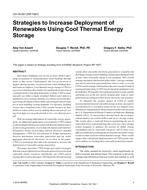Description
This paper is based on findings resulting from ASHRAE Research Project RP-1607.
Most larger buildings rely on one or more chillers operatingon-demand to instantaneously meet building thermal loads as they occur. Unfortunately, the cost of electricity is highest during daytime, on-peak periods when building thermal loads are highest. Cool thermal energy storage (CTES) isa proven technology that enables decoupling the production of cooling from the coincident demand for cooling. CTES systems typically use either a single stratified chilled-water tank or a multiplicity of ice storage modules as a means of storing thermalenergy during favorable chiller operating periods for later use to meet building cooling demands. For decades, building owners have benefited from CTES systems because of their ability to reduce utility costs by shifting the production of cooling from high cost on-peak periods to low cost off-peak periods.
With increasing deployment of renewable energy generation,an additional application is provided for CTES relatedto alleviating problems associated with this intermittent sourceof electricity generation. As a technically mature and relativelyinexpensive means of providing end-use electricity demandmanagement, CTES has the potential to bridge mismatchesbetween intermittent renewable generation and the utilityaggregate demand for electricity. As we show in this paper,CTES is a technology that offers the potential to increase thedeployment of renewable energy generation.
This paper describes CTES design and control strategiesthat aim to more effectively use the generation of electricity fromrenewable energy resources. Specifically, one CTES controlstrategy discussed in this paper will charge the thermal storagesystem when renewable electricity generation is available anddischarge storage to meet building cooling loads during periodsof time when renewable energy is not available. This controlstrategy maximizes the fraction of the chiller’s energy consumptionmet by electricity generated from wind or solar. A secondCTES control strategy will maximize the net economic benefit ofowning and operating a CTES system, based on equipment costsfor both the CTES and the renewable generation systems and theoperating cost of the net electric demand after wind or solargeneration according to a time-of-use electricity rate structure.
To illustrate the positive impact of CTES to enableincreased penetration of renewable energy systems, an analysisis performed for a secondary school in the Los Angeles area.Simulated cooling loads for the prototypical school are based onthe U.S. Department of Energy Commercial Reference BuildingModels (2011). To meet primary thermal loads, the secondary school employs air-cooled chillers and an ice storage system. The results show a trade-off between maximizing the use ofrenewable power and minimizing life-cycle cost, but a storage system designed to optimize the portion of chiller energy consumption met by renewable resources will be more cost effective and better at utilizing electricity from renewable energy resources than a system without thermal storage. These results suggest that widespread implementation of CTES systems may assist utilities in reaching their renewable penetration targets.
Citation: 2018 Winter Conference, Chicago, IL, Technical Papers
Product Details
- Published:
- 2018
- Number of Pages:
- 9
- Units of Measure:
- Dual
- File Size:
- 1 file , 1.4 MB
- Product Code(s):
- D-CH-18-001




